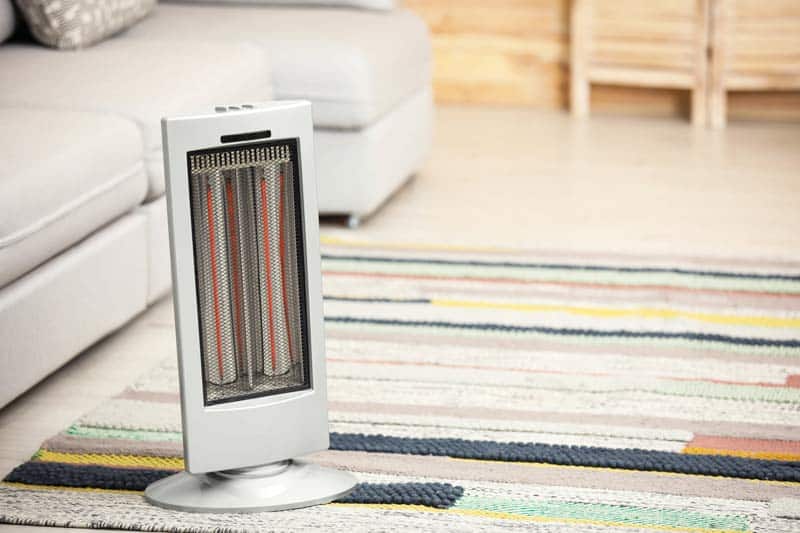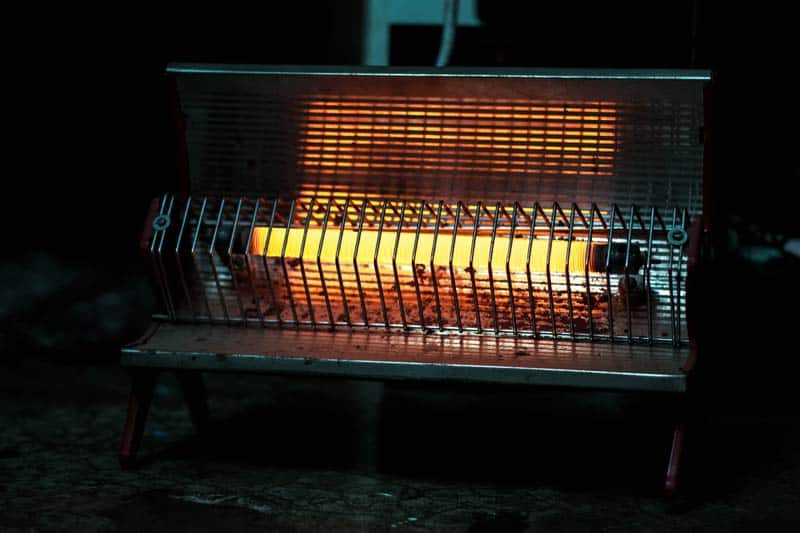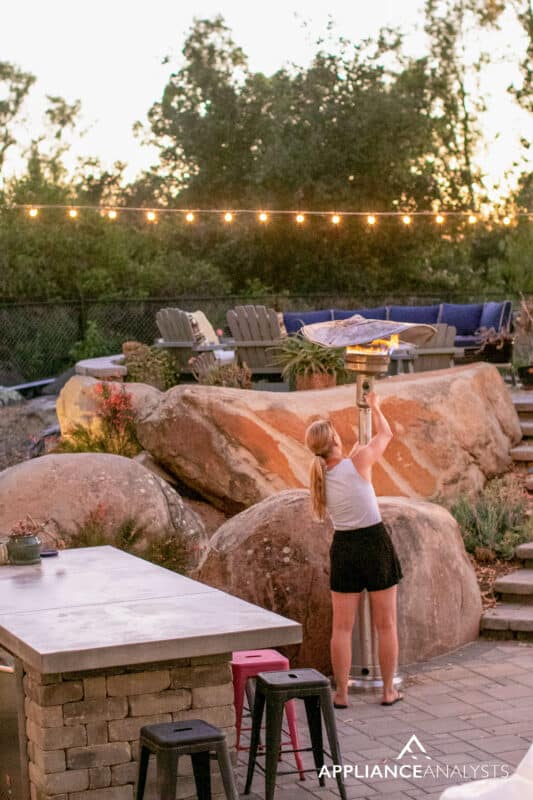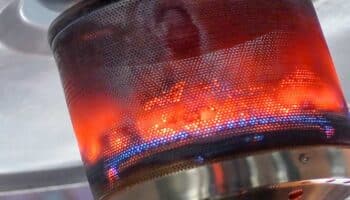We've independently reviewed this article to make sure it's as accurate as we can make it.
To find out more about our article creation and review process, check out our editorial guidelines.
Infrared vs propane patio heaters. They both have a lot to offer. Here are our hot takes on them.
As technology advances, humanity finds better, more efficient ways to solve everyday problems. Be it communication, health, or heating solutions, there’s no denying that every decade brings something new to make our lives easier.
While infrared heating technology is nothing new, it certainly is much more recent than its propane gas counterpart. In fact, the latter has been used in household appliances for almost two centuries!
You might be tempted to think that newer is always better, and while this may be true for cellphones or TVs, it may not be so for heating solutions.
The reality is that both infrared and propane patio heaters will provide you with what you’re looking for, warmth, and coziness. However, the main differences will lie in how each model goes about achieving this result.
I want to help you decide between both technologies and find an appliance that will solve your problems.
This is why I’ve prepared the list below, where you’ll find a list with the main differences between propane and infrared patio heaters, as well as the pros and cons of each one.
Definitions
Before we dive in, I want to quickly explain our terminology here. This article is mainly focused on electric infrared heaters vs larger propane heaters for use on a patio.
We aren’t touching on infrared heaters powered by propane, but you should be able to still get a good idea for those throughout the article.
Are you ready? Let’s go!
Comparing Infrared vs Propane Patio Heaters
As we advance in this article, we’ll delve into much more specific key aspects you should look out for. But before we do that, it’s essential to look at the bigger picture.
Propane Patio Heaters
Let’s begin by analyzing what propane heaters get right, and where they simply can’t compare to infrared technology.

| Pros | Cons |
| Longer-lasting warming effect | Require more maintenance and attention |
| Cheaper to run | Canisters need to be replaced |
| Slower warming up times | |
| Potential fire hazard |
Propane heaters are definitely a force to be reckoned with, but as you can see, they have their vulnerabilities. Let’s take a look at infrared heaters, and see how they do.
Electric Infrared Patio Heaters
Here are some of the most important advantages and disadvantages of this technology.

| Pros | Cons |
| Quicker heating | More expensive to run |
| Safer to run than propane variants | The warming effect doesn’t last as long |
| Lower pollution rates | |
| Low maintenance costs |
Key Aspects to Consider
Having discussed the general aspects of each model, we can now move on to more specific concepts and see where both truly shine.
Here’s what we’ll be comparing:
- Heating power
- Durability
- Safety
- Price
- Reliability
- Portability
#1 Heating Efficiency

This, along with the cost, will probably be the first thing you want to analyze. You’re buying a heating appliance, so knowing how well it will heat, and how efficiently it will use the energy provided, is a must.
While both infrared and propane models will get the job done very well, the difference between them lies in the way in which they go about achieving the desired results.
Propane models warm up the surrounding air, whereas infrared versions use heat waves to heat people and objects.
The problem with propane patio heaters is that not all the energy consumed will be turned into heat. Some might be lost in the process, so it’s not possible to say these appliances are 100% efficient.
Since infrared models use a more direct method of heating, almost all the electricity drawn from your wall outlet is utilized correctly.
Given that, in order to use either model, you’ll have to pay for gas canisters or higher electricity bills, you want to make sure your appliance makes the best of its energy sources.
#2 Durability
I’ll just come out and say it. While build quality is very important to determine how long an appliance will last, proper maintenance will have a much greater impact on its lifespan.
This is where a lot of people start leaning towards infrared patio heaters.
You see, since these only use electricity to function and produce heat, they are much easier to maintain than propane models, as the latter requires having a functional gas line, full canisters and clean pilots. If any of these components is faulty or dirty, it could cause other malfunctions inside the unit.
If we were only comparing durability in terms of build quality and lifespan, both appliances would be tied. However, when making these comparisons, it’s also crucial to consider how much neglect can reduce an appliance’s useful life.
Provided that you’re someone who doesn’t like doing regular maintenance on your appliances, buying a propane heater would be a bad idea, as it will require much more of you, than an infrared model.
#3 Safety

At this point, it’s starting to look like infrared patio heaters will be the clear winners of this comparison. And the following aspect might place them even further ahead.
Safety is something you should always have in mind whenever buying an appliance.
In theory, reading your user manual and following your manufacturer’s recommendations should keep you safe. But there’s always room for human error.
In general, infrared heaters are much safer than propane models due to the fact that the former utilizes electricity, whereas the latter needs gas and fire.
I’m not saying that infrared patio heaters can’t be a safety concern, If used improperly, they also can cause harm to you, and others. In fact, when misused, any household appliance is dangerous.
The problem with propane heaters is that they use highly-pressurized canisters and fire. This makes operating them a bit more challenging and creates the risk of explosions.
Now, there’s no reason to panic. While the aforementioned accidents are a possibility, there are several countermeasures built into propane heaters designed to prevent this from happening.
#4 Price
Just as it happens with any other household appliances out there, you can find either model in several price ranges.
If you’re only looking for something simple, $250 should get you a nice heater with a few features. And if you want as many extra bells and whistles as possible, there are models upwards of $1000 in the market.
It all comes down to your specific needs.
That being said, when considering the price of either patio heater, you should always take into account the associated expenses that come with each technology. While propane heaters will need you to replace their canisters regularly, infrared ones will only require you to pay the utilities.
And while running an infrared model might seem like the cheaper alternative, think again. This may vary depending on where you live, but usually, electricity is more expensive than propane gas per unit.
This means that you’ll end up paying more money every month to use an infrared heater, than you would for a propane one.
On the other hand, propane heaters require more maintenance and are less forgiving of neglect, which means you’ll have to pay more money for repairs and labor, than you would for an infrared alternative.
#5 Reliability
You’ll be happy to know that, in this area, both models shine.
As long as you buy your patio heater from a reputable vendor, you should not experience any problems. Both propane and infrared patio heaters have been designed to last for a very long time and provide you with continuous heating.
Having said that, and following along the lines of what was stated earlier, failing to regularly maintain and clean your appliances is a surefire way of making them malfunction.
While both patio heaters are very reliable, propane models will need you to pay more attention to them, than infrared ones.
The latter only requires you to pay your utilities on time every month in order to function. Whereas the former depends on your ability to remember to replace the canister, check the hose, and clean the pilot often.
This is one of those cases where reliability won’t be determined as much by the appliance itself, but rather by the user’s habits.
Again, if you know you’re someone who hates doing regular maintenance and tends to forget about checking propane levels, your best bet will be to go for an infrared model.
#6 Portability
Lastly, let’s discuss another very important, yet usually underestimated aspect.
Portability.
Being able to place a steady heat source wherever it’s needed, can be a blessing. Our everyday lives are hectic, and as such, necessities change fast, and frequently.
Owning an appliance that can adapt to these swift changes without giving you too much trouble, is essential. Being able to place your patio heater in one corner of your garden on Monday and across the room on Thursday, is an advantage that should not be underappreciated.
This is where propane heaters start getting ahead. We’ve already established that infrared models are safer to use, and much more energy-efficient, but when it comes to portability, they don’t have a lot to offer.

These patio heater versions rely greatly on electricity, and thus, wall outlets. While you can place your propane patio heater virtually anywhere in your home, you’ll have to plan strategically when it comes to infrared technologies.
Sometimes, you might even have to choose between charging your phone and staying warm. Moreover, in some cases, you might not even have the choice of relocation, as certain infrared patio heaters are wall-mounted.
In the end, it all comes down to your own specific needs.
Summary: Which One Is Best for You?
If I told you there’s a single answer to this question or a cookie-cutter solution, I’d be lying.
Which model is best for you will be determined greatly by several personal factors, such as electricity prices in your area, relocation necessities, and how prepared you are to give the appliance regular maintenance.
Some people love DIYs and find themselves constantly in the need to relocate their heat sources. Whereas others just want to plug in their patio heaters and enjoy the warmth without having to worry too much about anything else.
Before making any kind of decision, ask yourself, “What type of person am I?”. You’ll be able to tell which model you should get by answering that question.
Conclusion
These days, there are several options for every single product in the market. And while this is, for the most part, a good thing, sometimes it can also be overwhelming.
Choosing between an infrared and a propane patio heater can be challenging. However, I hope this article has helped you get a clearer idea of how each one works, and what they can offer you.
Just listen to yourself, and use the tools I have provided you with. I’m sure you need nothing more to make the right choice.
Thank you for reading. If you found this article helpful, I suggest you check out our other incredible resources below.
Happy shopping!
Frequently Asked Questions
Does Propane Smell?
Not naturally.
Just like the gas coming from your kitchen’s stove, propane is naturally odorless, but manufacturers add a smell for safety. Thanks to this measure, it’s easy to notice when you have a gas leak.
How Do I Maintain My Propane Patio Heater?
Propane patio heaters do require a little more attention from you than infrared variants, so, to give them good maintenance, you’ll have to clean them thoroughly.
Make sure to clean the burners, and the emitter screen, and constantly check for any damage to the canister and the gas line. Doing this about once a month is not a bad idea.
Can I Use a Propane Patio Heater in Windy Conditions?
It is not recommended.
Strong winds can blow out the flame and leave you with free-flowing gas. Also, the patio heater could be knocked over causing damage to the appliance and potentially setting objects on fire.
Can Patio Heaters Be Used on a Wooden Deck?
With enough caution, yes.
Patio heaters have what is known as a tilt switch, which is designed to cut off the gas supply from the canister to the burners when the appliance is inclined.
However, even with this feature, you should keep flammable objects away from the heater, and make sure that the unit is stable. Also, always make sure to read and follow your manufacturer’s recommendations.







